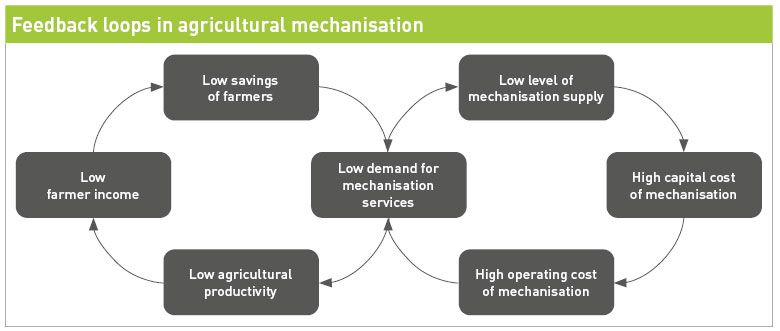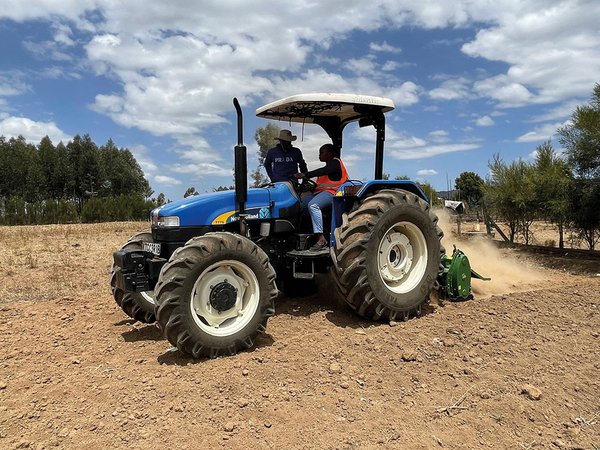 Download this article in magazine layout
Download this article in magazine layout
- Share this article
- Subscribe to our newsletter
Machinery rings – an innovative approach to mechanising Kenyan agriculture
Mechanisation in the agri-food sector remains a pillar of rural development in Africa. It helps to ensure a sustainable increase in production and to promote employment for young people, among others. However, smallholder farmers often still lack access to sustainable, modern and appropriate agricultural technology. This is exemplified by the situation in Kenya. According to a 2019 study, 26.3 per cent of Kenyan farming households had access to ploughs, 12.8 per cent to tractors and 4 per cent to combine harvesters. While the use of agricultural machinery is increasing, it remains at a low level. This is due to a number of factors that are interconnected (see Figure).
A business model driven by smallholder farmers
The continuing low level of mechanisation in the country is mainly due to the smallholder farmers' low level of capitalisation as well as the small size of the holdings and the associated high fixed costs for purchased agricultural machinery. This is precisely where the package of measures comes in that the Fund for the Promotion of Innovation in Agriculture (i4Ag – see Box on page 43) has been implementing in western Kenya since June 2021 in cooperation with sequa gGmbH and the Bundesverband der Maschinenringe e.V. (BMR, the German federation of machinery rings). Through direct contact with a local machinery ring and a digital platform, smallholders gain access to spare machinery capacity in exchange for a service fee.
Machinery rings are agricultural self-help organisations that focus on community and innovation. They provide machinery or machinery-based services and labour. A machinery ring does not normally own any machinery and does not employ its own staff – apart from management staff. The machinery provided usually belongs to individual farms or agricultural contractors.
The organisation coordinates the individual members’ supply and demand (machinery and labour capacities) and sets charges and standards for the completion of works. This creates transparency and brings economic (e.g. fair mechanisation costs and higher labour productivity) as well as social benefits (e.g. support during peak workloads or illness). In the event of a dispute between contractor and client, the machinery ring acts as an arbitrator. The organisations may also take on other business aspects for their members, such as the placement of labour or access to agricultural markets. The members decide on business activities and statutes. Farmers participating in farm machinery organisations have two options. Either they procure machinery themselves and contract out free capacities (e.g. via the digital platform), or they use other members’ services, for example for soil cultivation.
It is crucial for the success of the business model that the transaction costs for providing the service are kept low. In addition to the spatial proximity of the members, a sufficient infrastructure is indispensable. This is confirmed by John Rotich, chairman of a newly established local machinery ring in Kenya. For him, the great advantage of machinery rings for all parties involved is providing a time-saving mediated interface between the supply and demand sides. He sees the participants’ efficient organisation as the key to success.
The baseline study conducted prior to implementation showed that 91 per cent of the smallholder farmers surveyed would join a machinery ring; among providers of machinery-based services, the figure was as high as 97 per cent. The high demand was confirmed on foot of the first awareness-raising events, so that the project has been able to register 19 farm machinery syndicates at village level to date. Women constitute 51 per cent of the 3,800-strong membership.
In order to also make the service accessible to the more remote micro-farms despite the geographical distance involved, booking requests are to be bundled by the platform in future. Service providers will then only need to cover the distance once to serve multiple farms. All fields can be worked in one day, thus saving time and reducing costs.
Focus on soil cultivation
In many countries of sub-Saharan Africa, mechanised soil cultivation consists of a single, usually deep pass. Few farmers are aware of the benefits of more shallow soil cultivation, for example for incorporating crop residues or for seedbed preparation, or no-till techniques and the associated mechanical weed control. The requisite implements are therefore difficult to find on the market. This bias towards ever-repeating deep tillage is not only a reason for low yields, but also for progressive soil degradation. Without the incorporation of crop residues, organic material cannot decompose in the soil. This increases the spread of soil-borne plant pathogens and reduces humus formation, which in turn tends to lead to increased use of chemical pesticides.
In order to meet these challenges, the farm machinery rings provide their members with implements for conservation tillage on a rental basis (see Table below) and also offer training on climate-resilient agriculture. Smallholder farmers and micro-enterprises, most of whom tend to only own one tractor and one tillage implement, can thus expand their range of services, increase capacity utilisation of their machinery and implements, and impart and apply knowledge about conservation tillage techniques.
Gender strategy included
In its National Policy on Gender and Development, the Kenyan government aims to increase women's income, and specifically so in the agricultural sector. However, although women account for up to 75 per cent of the agricultural labour force in Kenya, they are still getting side-lined when it comes to mechanisation solutions, as at a societal level the operation of agricultural machinery continues to be perceived as a “man’s job”. The machinery rings have set themselves the goal of creating sustainable income potential for smallholder farmers by actively involving women and tailoring services to their needs. Alice Chepkorir Mabwai, a farmer and member of a machinery ring in western Kenya, welcomes the gender strategy: “Empowering women in farming is the greatest thing that we should achieve,” she says. The strong support offered by the machinery rings for the transformation to mechanised agriculture motivated her to become a member. As a manager of an agricultural holding, knowledge transfer is particularly important to her.
Ensuring sustainability by adopting a holistic approach
Instead of creating new dependencies, the project builds on strengthening smallholder farmers' communities and mobilising existing resources. The machinery rings in western Kenya are based on statutes and business principles that ensure equal benefits for all members. Membership fees and agency commissions, which cover the organisations’ running costs, are calculated and set collectively. Capacity-building on climate-resilient cultivation techniques is combined with business management topics, with a focus on the profitability of purchased agricultural machinery and its refinancing. In addition to the provision of machinery capacities for crop production, new business areas have already been identified in transport, processing and market access for agricultural products.
In the project area, increased demand for innovative mechanisation solutions and additional services in the value chain is already evident. The establishment of the machinery rings offers great potential to promote business opportunities for third parties (e.g. workshops, trade, contractors) and employment.
The Fund for the Promotion of Innovation in Agriculture
The Fund for the Promotion of Innovation in Agriculture (i4Ag) was launched in September 2020 by the Deutsche Gesellschaft für Internationale Zusammenarbeit (GIZ) GmbH on behalf of the German Federal Ministry for Economic Cooperation and Development (BMZ). Its aim is to develop gender-sensitive and sustainable innovations with partners who have a positive impact on food security, income and employment and/ or on the environment and climate. The package of measures, which has been implemented in Kenya as part of i4Ag since February 2021, aims to reduce the capital costs of mechanisation with the help of inter-farm concepts. An additional aim is to increase the low productivity of smallholder farmers through business management training and knowledge transfer on issues of climate-resilient cultivation techniques.
Claudius Bredehöft is Project Manager and Advisor in the Portfolio of Mechanisation in i4Ag at Deutsche Gesellschaft für Internationale Zusammenarbeit (GIZ) in Eschborn, Germany.
Contact: Claudius.bredehoeft(at)giz.de
Johanna Zimmermann is Planning Advisor in the Competence Center for Rural Development and Food Security at GIZ in Eschborn.
Contact: johanna.zimmermann(at)giz.de
References
Adu-Baffour, F., Daum, T. & Birner, R. (2019). Can small farms benefit from big companies’ initiatives to promote mechanization in Africa? A case study from Zambia. Food Policy, 84, 133–145. https://doi.org/10.1016/j.foodpol.2019.03.007
FAO (2013). Agricultural Mechanization in Sub-Saran Africa: Guidelines for preparing a strategy. https://www.fao.org/3/i3349e/i3349e.pdf
Daum, T. & Birner, R. (2020). Agricultural mechanization in Africa: Myths, realities and an emerging research agenda. Global Food Security, 26, 100393. https://doi.org/10.1016/j.gfs.2020.100393
Kirui, O. (2019). The Agricultural Mechanization in Africa: Micro-Level Analysis of State Drivers and Effects. SSRN Electronic Journal. Published. https://doi.org/10.2139/ssrn.3368103




